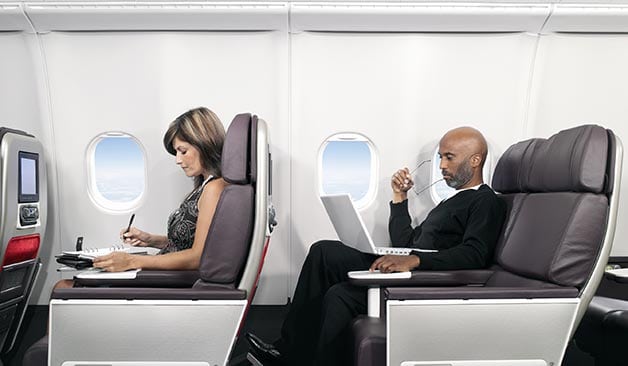Skift Take
There are lots of pennies to be made in Premium Economy—enough to add up to quite a lot of dollars.
Last week we launched our new report The Future of the Aircraft Cabin: Tracking Trends and Debunking Myths focused on the in-flight experience.
Below is an extract. Get the full report here to get ahead of this trend.
When many think of improved conditions for the Economy cabin, they immediately refer to the availability of a Premium Economy product.
In fact, Premium Economy is not one product but two distinct products, each of which works according to the airline model to which it is applied and to the cabin configuration in which it is used.
“There are two different approaches to Premium Economy seating,” Nigel Goode, Co-Founder of Priestmangoode tells us, “and that is important to note. European airlines offer a different seat entirely; whereas, in America, Economy Plus is more likely to be the same seat with more space—it’s not so much of a difference in products, but in space and services.”
This new Premium Economy class of service was first introduced by Virgin Atlantic in 1992, and was a revolutionary new way (for the time) of labelling cabin products to generate a three-class structure.
The Virgin Atlantic difference in Economy was entirely related to service and to “soft features,” like giving Economy passengers a fun keepsake amenity kit, and incorporating vibrant fabrics, and appealing design details. Virgin knew it wanted to define a strong brand, and considered every element of the cabin and the cabin experience holistically—to powerful effect.
We must also mention Virgin Atlantic’s excellent standards for cabin service and hospitality throughout the aircraft. Economy Class at Virgin Atlantic was very similar to Economy Class on other carriers. Yet the airline became very popular and very successful because passengers felt much more comfortable affordable on a Virgin Atlantic flight. Virgin Atlantic is an exceptional case-study of how effective holistic branding can change passenger perspective in the Economy cabin, even when structural conditions are not significantly differentiated.
Though seats were improved, they were still similar enough to Economy seats that the Upper Class cabin and its own host of unique service features were still more attractive to those who could afford it. The majority of the features in Premium Economy attractive to passengers at the time, were not dependent on structural features alone. Look at the list of features listed on the Virgin Atlantic sales brochure of the time: Seats were longer and wider, increased knee room, pre-flight glass of champagne, a personal TV screen, Nintendo and PC games, a choice of three meals, and fresh fruit available throughout the flight.
The other features which made Premium Economy Class such a special experience are all “soft” cabin elements; including, what is not listed in this list but was a very nice piece of kit—the better Premium Economy amenity kit.
What Virgin Atlantic did was special, profitable, and enduring because of the customers it targeted. It worked on a very human factor: that all of us, regardless of class, have a little elitism in our veins. We all want to be a bit better off than our peers. We all want special treatment, and are willing to pay for as much special treatment as our wallets can afford.
This psychology and this product positioning is essential to the success of a Premium Economy cabin offering. It must fit in a Goldilocks zone. It must be affordable enough for Economy passengers with a little extra change in their wallets to spring for the upgrade, while not being so comfortable a product offering that it competes with the airline’s Business Class.
Getting that balance right is not always easy. It is the predominant factor which puts the whole concept of Premium Economy at peril with some carriers. It just doesn’t work for their brand strategy, it doesn’t help their goal of selling Business Class seats.
However, Goode has an important point to make for airlines who are on the fence about continuing a Premium Economy class service. “If airlines are operating Premium Economy well,” he tells Skift, “it is the most profitable class in the cabin.”
The Daily Newsletter
Our daily coverage of the global travel industry. Written by editors and analysts from across Skift’s brands.
Have a confidential tip for Skift? Get in touch
Tags: virgin atlantic
Photo credit: The current-day Premium Economy on Virgin Atlantic. Virgin Atlantic
